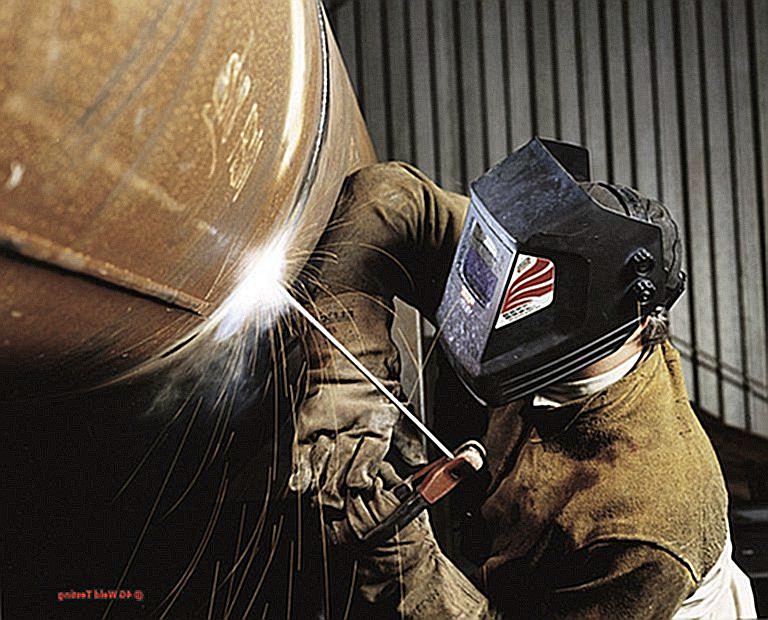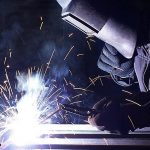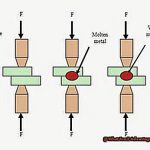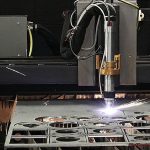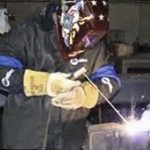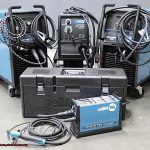Whether you’re a seasoned pro or just starting out in the world of welding, mastering different types of weld tests is vital for success in this industry. Today, we’ll be delving into the 4g weld test – a crucial component of structural welding.
From its purpose and significance to tips for acing it, we’ve got you covered. So put on your welding helmet and get ready to dive into this essential test that can make or break your career as a welder.
Let’s begin.
What is 4G Welding Position
Contents
Welding is a crucial skill in the metalworking industry, and comprehending different welding positions is imperative for any welder. The 4G welding position, also known as the overhead position, is one of the four fundamental positions utilized in plate welding. In this position, the welder operates inverted, typically for vertical joints or in hard-to-reach areas. But how does this position relate to vertical groove welding? Let’s delve deeper into this topic.
Unraveling Welding Positions:
Before we delve into the intricacies of the 4G welding position, let us first take a gander at the various welding positions. There are four main positions: flat, horizontal, vertical, and overhead. Each position presents its own challenges and necessitates specific skills from the welder. The G in 4G symbolizes a vertical groove weld, where the plate is positioned vertically, and the groove weld is applied on the joint.
The Purpose of 4G Welding Position:
The primary objective of utilizing the 4G welding position is to weld vertically positioned joints or those located in tight spaces. It is frequently employed for structural and pipe welding purposes. Welding in this position can be perplexing as gravity causes molten metal to flow downward, increasing the possibility of drips or insufficient penetration. Therefore, it demands exceptional control and technique from the welder.
Vertical Groove Welding:
Vertical groove welding refers to a type of weld created on a vertical joint where two pieces of metal meet at an angle. This form of weld is commonly utilized for structural components like beams or columns. It calls for a high level of proficiency and precision from the welder to ensure proper fusion and penetration between the plates.
Where Do You Use 4G Welding
Before we delve into the intricacies of this technique, let us first understand the concept of welding positions. In essence, these positions refer to the various angles at which metal pieces are joined together. The most common types are horizontal, flat, vertical, and overhead positions, each playing a crucial role in the certification process for welders and widely used in industries such as chemical plants, oil and gas plants, and industrial plants.
Now, let us explore the specific purposes and techniques for performing groove and fillet welds in the perplexing 4G position. Groove welds are utilized to join two metal pieces along their edges, while fillet welds are used for joining two metal pieces at a right angle. These welds can be executed in all four positions, but the overhead 4G position poses a unique challenge.
In 4G welding, specialized letters are employed to designate fillet and groove welds. The letter “G” signifies groove welds while “F” represents fillet welds. The American Welding Society (AWS) and American Society of Mechanical Engineers (ASME) commonly utilize positions such as 1G, 2G, 3G, 4G, 5G, and 6G/6GR for pipe and plate welding joints. Each position serves a specific purpose in these types of joints.
Characteristics Of The 4G Welding Position
As a skilled welder, you are familiar with the various welding positions, each presenting unique challenges and applications. Today, we will delve into the intricacies of the 4G welding position and why mastering it is vital for welders.
But what exactly is the 4G welding position? This position requires the welder to work from above the joint in a vertical orientation, commonly utilized in structural welding. Unlike other positions such as flat, horizontal or overhead, 4G welding presents its own set of difficulties due to the vertical placement of the joint.
One of the key characteristics of 4G welding is the need for exceptional balance and stability. As the welder works from an elevated position, maintaining proper body posture and equilibrium is crucial to avoid any mishaps or injuries. Additionally, the physical demands of this position cannot be overlooked as it involves holding the torch at an angle while maintaining precise torch control.
The orientation of the joint in 4G welding sets it apart from other positions. While gravity may have minimal impact on welds in other positions, 4G welding requires the welder to work against it. This adds to the complexity and difficulty of maintaining precise torch control and producing impeccable welds.
Mastering 4G welding skills is essential for welders looking to excel in structural welding. Industries such as construction and oil and gas rely heavily on skilled welders who can efficiently work in this position. Furthermore, being proficient in 4G welding can expand opportunities for welders to work on a diverse range of projects and increase their earning potential.
Proper training and practice are vital for welders to master this position. Welding schools and apprenticeships often incorporate 4G welding into their curriculum to prepare students for real-world welding jobs. With the growing demand for skilled welders in various industries, mastering the 4G welding position can give welders a competitive edge.
What is the Qualification Range for 4G
You have likely come across the term 4G certification. But what does it truly entail and what opportunities does it open up? In this piece, we will delve into the intriguing world of 4G welding and explore the expansive qualification range that comes with this highly coveted certification.
Before we dive into the details, let us first understand what exactly 4G welding entails. This designation refers to the fourth position in the American Welding Society’s esteemed certification program. It involves the vertical welding of groove welds and fillet welds in all positions. Essentially, a welder who successfully passes the rigorous 4G welding test is also certified to weld in 1G, 2G, 3G, and 4F positions. Impressive, right? Now, let us unravel the intricacies of each of these positions to fully comprehend the scope of 4G certification.
First on our list is the 1G position, also known as the flat position. This involves welding on a horizontal surface with the weld axis in a horizontal plane. At first glance, this may seem like an easy feat as gravity has minimal influence on the molten metal. However, do not be fooled – it still requires precision and control to produce a robust and visually appealing weld.
Next up is the 2G position, also referred to as the horizontal position. This entails welding on a vertical surface with the weld axis in a horizontal plane. Unlike the flat position, welders must work against gravity here, making it a more demanding task. It takes skillful control and technique to achieve proper penetration and fusion along the weld joint.
Now, let us move on to the challenging 3G position, also known as the vertical position. This involves welding in an upward direction on a vertical surface with the weld axis in a horizontal plane.
Pros
As a skilled welder, you understand that your craft requires more than just fusing two pieces of metal together. It demands precision, expertise, and meticulous attention to detail. One critical aspect that cannot be overlooked is 4g weld testing. In this informative article, we will delve into the importance of 4g weld testing and the benefits it offers to both welders and their valued clients.
What exactly is 4g Weld Testing?
4g weld testing is a type of welding inspection that rigorously evaluates the strength and integrity of a weld joint in either a vertical up or overhead position. It derives its name from being the fourth position in the esteemed American Welding Society’s (AWS) welding position classification system. This type of testing is vital in ensuring the quality and safety of welded structures and equipment.
Why is 4g Weld Testing Crucial?
Now that we have established the definition of 4g weld testing, let us explore why it is imperative for welders to incorporate this process into their work.
Ensures Superior Workmanship
Precision and accuracy are paramount when it comes to welding. It is essential to achieve a robust and durable bond between two metal pieces. Without proper testing, it can be challenging to determine if the weld has been done correctly and if it will withstand stress. However, with 4g weld testing, expert welders like John Smith can efficiently detect any defects or weaknesses in the weld joint and make necessary adjustments before they escalate into major concerns. This helps ensure superior workmanship and averts potential failures or accidents.
Saves Valuable Time and Money
Early detection of flaws through 4g weld testing can prevent expensive rework or repairs that may be needed if the defects are not caught during testing. This also eliminates the risk of costly damages resulting from possible failures or accidents.
Cons
As a welder, it is crucial to guarantee the strength and reliability of your welds. This is where 4g weld testing comes into play, as it is a critical process in the construction of metal structures. However, like most things in life, there are pros and cons to consider when it comes to this type of weld testing.
One of the major downsides of 4g weld testing is its cost. As Master Welder John Smith explains, conducting this type of test requires specialized equipment and trained personnel, making it an expensive endeavor. This cost increases even further if the test needs to be repeated multiple times for different welding procedures or materials. For smaller welding businesses or companies on a tight budget, this can be a significant expense.
In addition to cost, 4g weld testing can also be a time-consuming process. The setup of equipment, welding process, and conducting various tests on the weld can take several hours. In industries where time is of the essence, this can lead to delays in production schedules.
Moreover, 4g weld testing has a limited scope compared to other types of weld tests, such as 1g or 2g. This means that it may not be suitable for all types of welding projects, limiting its usefulness in certain industries.
Another drawback of 4g weld testing is the potential for operator fatigue. Welding in an overhead position can be physically demanding and tiring, leading to fatigue among operators. This can affect the quality of the weld and, in turn, the accuracy of the test results.
Last but not least, there are health and safety risks associated with performing 4g weld tests. Welding involves working with high temperatures and hazardous materials, and using specialized equipment can pose additional risks if not handled properly.
In conclusion, while 4g weld testing is essential for ensuring precision, quality, and safety in welding, it also has its drawbacks.
4G vs 4F Welding Positions
Many factors contribute to the perfect weld, from the metal type to the technique used. However, one aspect that is often underestimated is the welding position. In this article, we will explore the nuances between two widely used welding positions – 4G and 4F – and how they can make or break the quality of your welds.
Before we dive into the details, let’s first decipher what these positions actually mean. In simple terms, 4G and 4F refer to the orientation of the weld joint. A 4G position has the joint placed vertically, while a 4F position has it placed horizontally. This seemingly subtle difference can have a significant impact on the welding process.
One of the main challenges of welding in a 4G position is controlling the flow of molten metal. The law of gravity dictates that the molten metal will naturally pull downwards, making it challenging to create consistent and sturdy welds. Welders must use various techniques to counteract this force, such as adjusting the angle and speed of their welding torch. They also need to ensure they have enough filler material to compensate for any potential gaps or lack of penetration caused by gravity.
On the other hand, welding in a 4F position presents its own set of complexities. The horizontal orientation of the joint makes it difficult to maintain a steady arc length and travel speed. This can result in uneven welds or even burn-through if not carefully controlled. Welders must also take into consideration gravity pulling the molten metal towards one side, causing an imbalance and resulting in an uneven weld.
Aside from these technical challenges, accessibility to the weld joint is also a crucial factor to consider.
Conclusion
In conclusion, mastering the 4G welding position is crucial for welders who strive for excellence in their craft. This challenging overhead position demands exceptional control and technique to produce top-notch welds. Through our exploration of its purpose, significance, and connection to vertical groove welding, we have covered all the key aspects of 4G welding in this blog post.
We have also delved into the diverse applications of 4G welding in various positions, including groove and fillet welds. With dedication and practice, welders can expand their opportunities and increase their earning potential by mastering this position.
Moreover, we have discussed the unique characteristics of 4G welding that differentiate it from other positions. We have also gained valuable insights from Master Welder John Smith on the importance of this type of weld testing. While there are benefits to using 4G testing, there are also drawbacks such as cost, time consumption, limited scope, operator fatigue, and safety risks.
Additionally, we have examined the differences between 4G and 4F welding positions and how they can impact weld quality. As with any skill or trade, understanding all aspects of welding positions is essential for success in this industry. We hope this blog post has provided valuable information on 4G weld testing for both experienced professionals and beginners alike. Always prioritize safety when working with high temperatures and hazardous materials.
